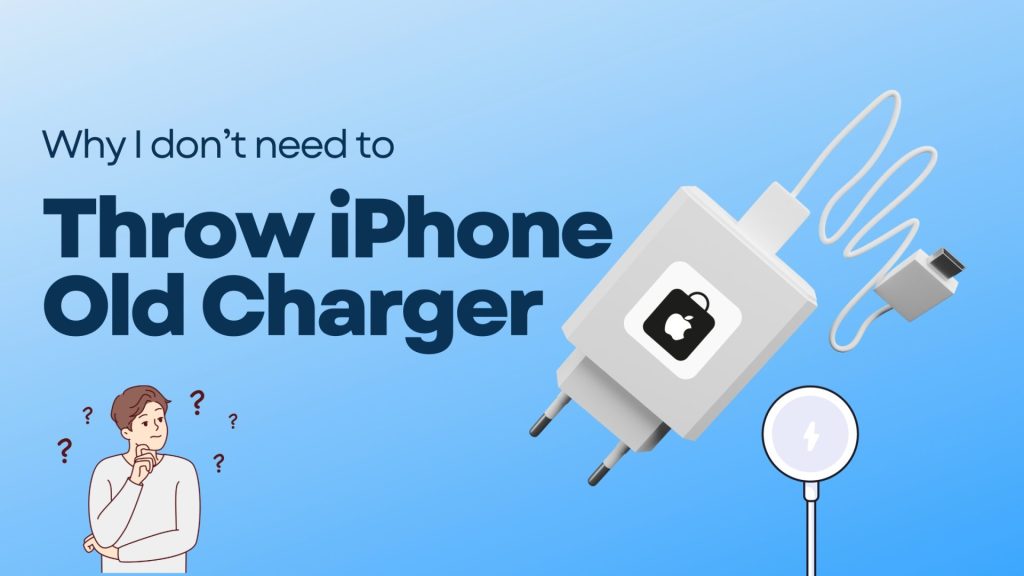Dear user Don’t throw away your old charger, they will be compatible with the new iPhone series.
Since the iPhone 12, Apple no longer includes wall adapters to reduce package waste and offer additional accessories for purchase.
The newer iPhone models, including the iPhone 15 lineup, support Apple’s MagSafe charging.
Users may need to consider purchasing charging accessories separately for their iPhone 12, 13, 14, or 15 models due to this packaging change.
Are iPhone chargers all the same?
Not all iPhone chargers are the same, though they have some similarities.
Lightning connector: All iPhones since the iPhone 5s use the Lightning connector for charging, providing a consistent connection to chargers and cables.
Basic functionality: Genuine or MFi-certified chargers can charge iPhones, but they differ in charging speeds.
Differences: Power output: Chargers vary in wattage (from 5W to 30W), impacting charging speed; higher wattage means faster charging.
Cable type: While all have Lightning connectors, older chargers might use USB-A, while newer ones use USB-C for wider compatibility.
Additional features: Some chargers offer fast charging protocols, multiple ports, or wireless charging capabilities.
In-box chargers: Since 2020, Apple doesn’t include chargers with new iPhones, giving users the flexibility to choose chargers with desired features.
Considerations:
iPhone model: Different models have varied charging requirements and cable types; older models might not support newer fast charging tech.
Third-party chargers: Non-Apple chargers should be MFi-certified for safety and reliability, as uncertified ones can damage iPhones or pose safety risks.
Is the iPhone 11 or 14 charger the same?
US iPhone users can rejoice as the iPhone 11 charger is compatible with the new iPhone 14.
Both devices utilize the same Lightning connector, ensuring that the older charger will fit and function perfectly with the new iPhone model.
Are all iPhone charger adapters the same?
Certified adapters offer more than just a power supply. They communicate the power source’s capacity to the connected device, a feature absent in non-certified or counterfeit adapters.
Using unauthorized adapters, even if they appear identical to Apple’s, has resulted in fatalities.
The critical factor distinguishing them is input-output isolation, ensuring that neither side of the AC power connects to the 5-volt side and there’s no failure mode risking this isolation.
Many manufacturers compromise on this crucial safety feature.
Are iPhone XS Max and iPhone 11Pro Max chargers the same?
The charger compatible with the iPhone XS Max is perfectly safe and compatible with the iPhone 11 Pro Max as well. No need for concerns when using the same charger for both devices.
Does the iPhone SE or iPhone 6 charger the same?
Both the iPhone SE and iPhone 6 utilize Apple’s Lightning connector for charging.
As a result, you can conveniently use the same charger for both these iPhone models without any issues.
Can we use the same charger on iPhone and iPad?
For the majority of modern iPhones and iPads featuring the Lightning connector, it’s generally feasible to use the same charger interchangeably for both devices.

Is it OK to use a different iPhone charger?
Sure, it’s okay to use a different iPhone charger depending on various factors.
1. Compatibility:
Connector: Ensure the charger has the correct Lightning connector for your iPhone model.
Wattage: Opt for a charger with wattage meeting or exceeding your iPhone’s needs.
Certification: Apple recommends using MFi-certified chargers for safety and reliability.
2. Safety:
Uncertified chargers: Carry risks like overheating or damage; prioritize certified chargers.
Physical condition: Avoid visibly damaged chargers to prevent safety hazards.
3. Performance:
Faster charging: Newer iPhones support fast charging (20W+), while basic chargers (5W) charge slower.
Compatibility issues: Non-Apple chargers may not work optimally for features like data transfer or accessories.
Consider compatibility, safety, and performance factors when using different chargers with your iPhone for optimal functionality and safety.
iPhone those support Lightning to USB-C and Lightning to USB-A Cable
If you own any of these iPhone models – from the iPhone 5 through the latest iPhone 14 series – you can use either a Lightning to USB-C or a Lightning to USB-A cable with your device.
1. iPhone 14, 14 Plus, 14 Pro, and 14 Pro Max
2. iPhone 13, 13 mini, 13 Pro, and 13 Pro Max
3. iPhone 12, 12 mini, 12 Pro, and 12 Pro Max
4. iPhone 11, 11 Pro, and 11 Pro Max
5. iPhone SE (1st, 2nd, and 3rd generation)
6. iPhone X, XR, XS, and XS Max
7. iPhone 8 and 8 Plus
8. iPhone 7 and 7 Plus
9. iPhone 6, 6 Plus, 6S, and 6S Plus
10. iPhone 5, 5C, and 5S
iPhone that supports 30-pin to USB-A Cable
For iPhones released between 2007 and 2012, including the iPhone (1st generation), iPhone 3G, 3GS, 4, and 4S, you’ll need a 30-pin USB-A cable for charging and connectivity.
How to ensure the best iPhone adapter?
When selecting a power adapter for your iPhone:
1. Ensure it has the correct USB port matching your cable: USB-C for USB-C cables or Lightning to USB-C cables, USB-A for 30-Pin to USB-A or Lightning to USB-A cables.
2. Consider the wattage: Higher wattage charges faster but results in a larger adapter. Options range from 5W to 30W, offering different charging speed
3. Any wattage works, but at varying speeds; choose according to your preference.
4. Check the adapter’s compatibility with your country’s power system.
For international travel, consider Apple’s World Travel Adapter Kit to avoid potential damage to your devices from substandard adapters.
Is it OK to use a different iPhone charger?
Using a different iPhone charger is fine, but ensures compatibility, safety, and performance.
Use the correct connector (e.g., Lightning or USB-C) for your iPhone model. Opt for Apple-certified or MFi-certified third-party chargers for safety and reliability.
Be cautious with uncertified chargers to avoid risks like overheating or damage. Also, consider the charger’s wattage for optimal charging speed.
Did the old charger damage the iPhone 14?
While using an old charger for your iPhone 14 won’t likely damage it, there are considerations for the US audience:
Compatibility:
The iPhone 14 uses the same Lightning connector, so the old charger will physically fit and charge the phone.
Performance:
Wattage Differences: Older chargers typically have lower wattage, resulting in slower charging compared to newer, faster chargers (20W+).
Fast Charging: The iPhone 14 supports fast charging, but older chargers might not, affecting the phone’s full charging potential.
Safety:
Certification: MFi-certified chargers are recommended for safety and reliability. Older chargers might lack this certification.
Overall, while safe, using an old charger might be inconvenient due to slower charging and missing out on fast charging.
Consider a charger with matching or higher wattage (20W+), and MFi certification, or explore wireless chargers compatible with your iPhone 14 for optimal performance and convenience.
Can I use an iPhone 7 charger for the iPhone 14?
Using your iPhone 7 charger for your iPhone 14 in the US is safe, but here’s what to consider:
Compatibility:
Both iPhone 7 and iPhone 14 use the same Lightning connector, so the charger will physically fit and function.
Performance:
Differences: Wattage: The iPhone 7 charger (likely 5W) will charge the iPhone 14 much slower than the recommended 20W or higher adapters.
Fast Charging: The iPhone 7 charger won’t support the faster charging capabilities of the iPhone 14.
Safety:
MFi-Certification: While the iPhone 7 charger is likely safe, MFi-certified chargers are recommended for assured safety and compatibility.
Overall, the iPhone 7 charger will work but won’t be the most efficient choice. Expect slower charging times and missing out on the iPhone 14’s fast charging capabilities.
For better performance:
Use a charger with 20W+ wattage.
Opt for an MFi-certified charger.
Explore wireless charging options compatible with your iPhone 14 and supporting Qi charging.
Are the iPhone 13 or iPhone 6 chargers the same?
Using an iPhone 6 charger for an iPhone 13 is feasible, but it will charge significantly slower compared to a 20W charger.
1. Ensure it’s a genuine Apple charger when using an iPhone 6 charger to prevent potential damage to your iPhone.
2. To leverage the faster charging capabilities of the iPhone 13, investing in a 20W charger is necessary.
Are iPhone Wireless Chargers compatible with all iPhones?
Not all iPhone wireless chargers are compatible with all iPhones.
Compatible Wireless Chargers:
Standard Qi Wireless Chargers: Offer basic 5W or 7.5W charging and work with iPhone 8 and newer models that support wireless charging.
Compatibility Limitations:
MagSafe Wireless Chargers: Introduced with iPhone 12, these offer faster charging and precise alignment using magnets but are only compatible with iPhone 12 and later models. Older iPhones with wireless charging won’t benefit from MagSafe features.
Older iPhone Models: iPhone 7 and earlier lack built-in wireless charging. To use wireless charging, an additional accessory like a Qi-enabled case is necessary.
Considerations:
Case Compatibility: Thick or metallic cases might hinder wireless charging, especially with MagSafe. Ensure your case is compatible with the chosen charger type.
Charging Speed: MagSafe chargers are faster than standard Qi chargers. For faster charging, consider a MagSafe charger compatible with your iPhone model.
Conclustion
To reduce environmental impact, iPhone models no longer include a power adapter.
However, they are compatible with existing power adapters and USB-A to Lightning cables from prior models.
Now, iPhones come with a USB-C to Lightning cable in the box, supporting fast charging and compatibility with USB-C power adapters and computer ports you may already possess.
Adapters you can use to charge your Apple devices include those listed in the documentation, Mac USB-C Power Adapters, and third-party adapters complying with safety standards.
For more detailed charging information, refer to the Safety, Handling, and Support section in the respective device user guides (iPhone, iPad, Apple Watch, or iPod).
